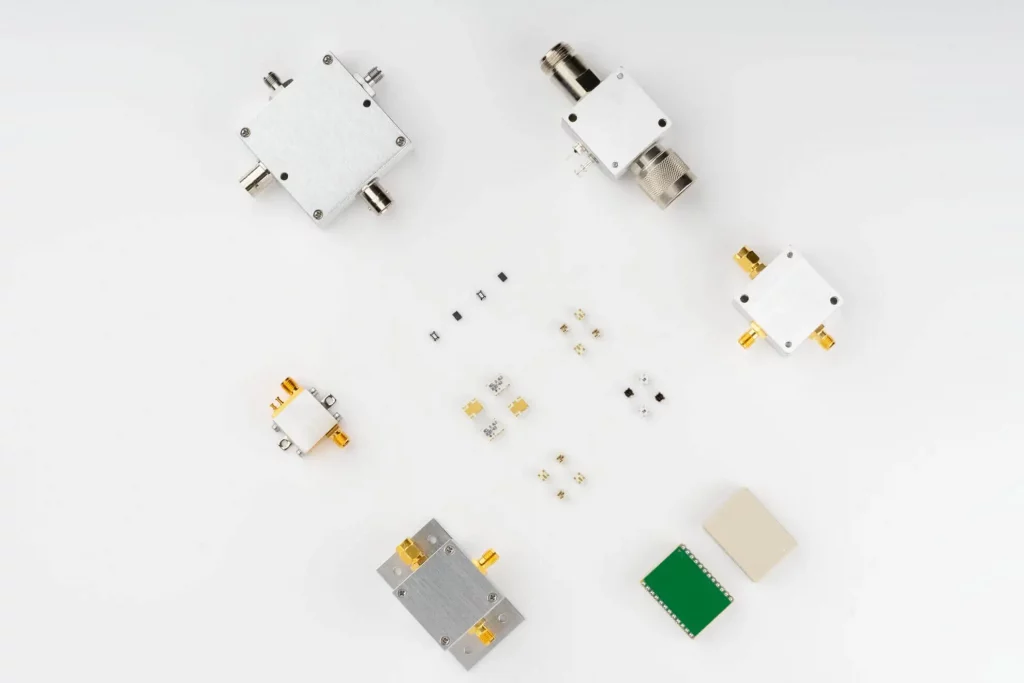

The first type of RF bias tee is the passive bias tee. As the name suggests, passive bias tees do not require any external power source and rely on the RF signal to generate the DC power needed to bias the active device. Passive bias tees are typically used in applications where the DC power requirements are low, such as in low-noise amplifiers.
Another type of RF bias tee is the active bias tee. These bias tees require an external power source, and use active components, such as transistors or diodes, to generate the DC power needed to bias the active device. Active bias tees are commonly used in applications where the DC power requirements are high, such as in power amplifiers.
A programmable bias tee is a type of RF bias tee that can be controlled by a computer or other external device to change the DC bias voltage or current. These bias tees are commonly used in applications where precise control of the DC bias is required, such as in test and measurement equipment.
A high-power bias tee is a type of RF bias tee that is designed to handle high levels of RF power. These bias tees are commonly used in applications where high-power signals are present, such as in radio and television broadcasting.
A hybrid bias tee is a type of RF bias tee that combines two or more different types of bias tees, such as a passive and an active bias tee, to provide a wide range of DC bias levels. These bias tees are commonly used in applications where a wide range of DC bias levels is required, such as in test and measurement equipment.
Wideband RF bias tees are passive devices used to separate a DC voltage or bias signal from an RF signal in an RF system. They typically consist of a capacitor and an inductor, which are used to combine or separate the DC and RF signals, respectively. The DC bias signal is typically used to power an active device in the RF system, such as an amplifier or oscillator. The RF signal, on the other hand, carries the modulated data or information that is being transmitted or received by the system. Wideband RF bias tees are designed to operate over a wide frequency range, typically from a few MHz to several GHz or higher. They are commonly used in applications such as RF amplifiers, mixers, filters, and antennas. The performance of a wideband RF bias tee is typically specified in terms of its insertion loss, frequency range, DC blocking voltage, and power handling capacity. They are available in different configurations, including surface-mount and through-hole, to suit different applications and installation requirements.
Diplexer RF bias tees are passive devices used to combine or separate two RF signals at different frequency bands, while also separating a DC bias signal from the RF signals. They typically consist of two inductors and two capacitors, which are used to combine or separate the RF signals, and a capacitor or series inductor which is used to separate the DC bias signal from the RF signals. The diplexer RF bias tee allows for the simultaneous transmission or reception of two RF signals at different frequency bands, while also providing a DC bias signal to an active device such as an amplifier or oscillator. They are commonly used in RF systems that operate at multiple frequency bands, such as in communication systems or radar applications. The performance of a diplexer RF bias tee is typically specified in terms of its insertion loss, frequency range, DC blocking voltage, and power handling capacity. They are available in different configurations, including surface-mount and through-hole, to suit different applications and installation requirements.
MMIC (Monolithic Microwave Integrated Circuit) RF bias tees are compact and highly integrated devices used to separate a DC bias signal from an RF signal in an RF system. They are typically fabricated using semiconductor technologies and integrated with other RF components such as amplifiers, filters, and mixers on a single chip. MMIC RF bias tees use passive elements such as inductors and capacitors to combine or separate the DC bias signal and the RF signal, and are designed to operate over a wide frequency range. They offer high performance, low insertion loss, and are capable of handling high power levels, making them ideal for use in high-frequency RF systems, such as those used in aerospace and defense applications. The performance of an MMIC RF bias tee is typically specified in terms of its frequency range, insertion loss, DC blocking voltage, and power handling capacity. They are available in different configurations and package types, such as surface-mount or flip-chip, to suit different applications and installation requirements.
In conclusion, RF bias tees are an essential component in a wide range of electronic systems. The different types of RF bias tees offer unique characteristics and capabilities, making them suitable for different applications. Whether you need a passive bias tee for a low-noise amplifier or a high-power bias tee for a radio transmitter, there is an RF bias tee that can meet your needs. Understanding the characteristics of different types of RF bias tees can help you choose the right one for your application, ensuring that your system functions correctly and efficiently.
Mini-Circuits offers a wide of catalog RF Bias Tees, including Surface-Mount, Diplexers, Wideband, Coaxial and plug-in components for DC current up to 5 Amps and RF bandwidths spanning 100 kHz to 54 GHz for all types of applications and mounting preferences. View the catalog: https://mcdi-ltd.com/rf-bias-tees/
MCDI, Mini-Circuits Exclusive Representative in Israel, serves as the direct link for customers in Israel to Mini-Circuits’ world class selection of high-quality RF, IF and microwave products from DC to 95 GHz.
Our strong partnership with Mini-Circuits and Mini-Circuits Israel, the Mini-Circuits design center in Israel, allows us to provide customers with direct access to local technical service and engineer-to-engineer application support.